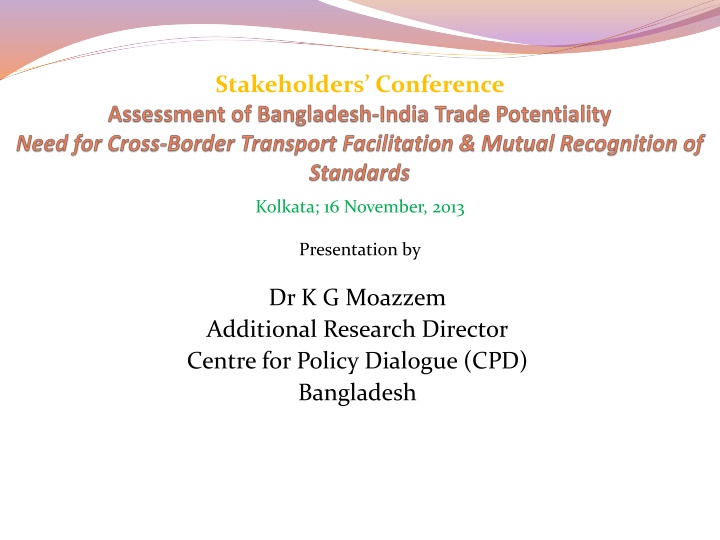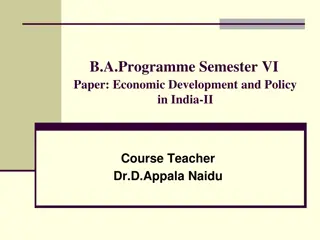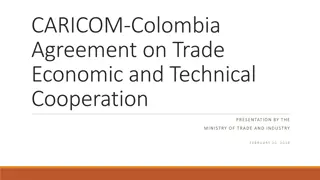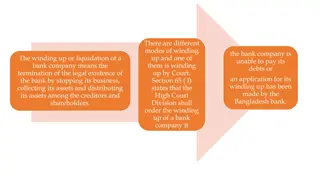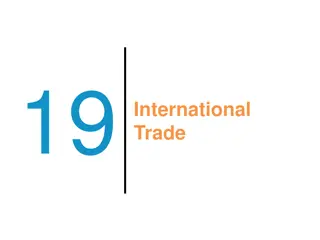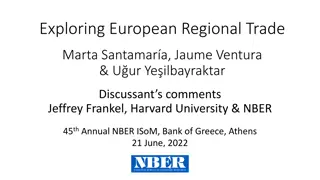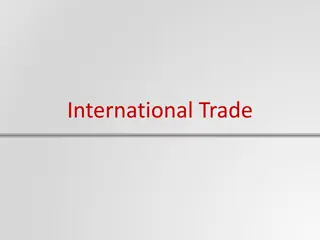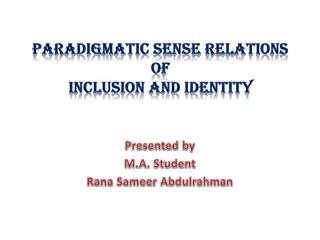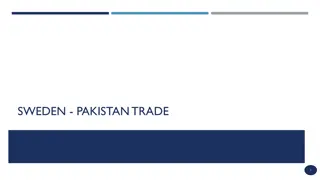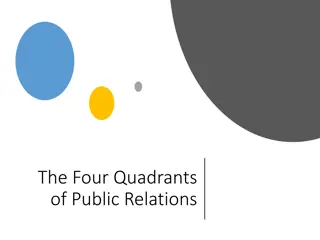Stakeholders Conference Presentation on Bangladesh-India Trade Relations
Dr. K.G. Moazzem, Additional Research Director at the Centre for Policy Dialogue (CPD) in Bangladesh, presented at the Stakeholders Conference in Kolkata on the ongoing studies, goals, and key findings related to the Bangladesh-India trade relationship. The presentation highlighted the objectives of the studies, including addressing SPS issues, assessing trade facilitation benefits, and pushing the agenda for cross-border transport facilitation. It also outlined the findings from the first phase of the study, focusing on the trends in bilateral trade, export concentration, and product diversification between the two countries from 2001 to 2012.
Download Presentation

Please find below an Image/Link to download the presentation.
The content on the website is provided AS IS for your information and personal use only. It may not be sold, licensed, or shared on other websites without obtaining consent from the author.If you encounter any issues during the download, it is possible that the publisher has removed the file from their server.
You are allowed to download the files provided on this website for personal or commercial use, subject to the condition that they are used lawfully. All files are the property of their respective owners.
The content on the website is provided AS IS for your information and personal use only. It may not be sold, licensed, or shared on other websites without obtaining consent from the author.
E N D
Presentation Transcript
Stakeholders Conference Kolkata; 16 November, 2013 Presentation by Dr K G Moazzem Additional Research Director Centre for Policy Dialogue (CPD) Bangladesh
Contents Ongoing Studies: Goals and Objectives 1. 2. Key findings from the first phase of the study 3. Need and rationale for the second phase of the study 4. How to/why push the agenda for cross-border transport facilitation and mutual recognition of standards 5. The Expected outcomes/benefits 6. Outline of a model to quantify the benefits accruing from cross-border trade facilitation 2
1. Ongoing Studies: Goals and Objectives Two studies are being carried out by CPD and CUTS Study on Addressing SPS issues and concerns in Bangladesh-India Trade: Design of a Draft SPS Agreement Study on Assessing Benefits of Trade Facilitation through Bangladesh India MVA Study on SPS Issues: Goals and Objectives Identify SPS related concerns Prepare mechanism for SPS related dispute settlement Prepare draft SPS agreement Come up with a framework for MRA Suggest actions for enforcement of the agreement 3
1. Ongoing Studies: Goals and Objectives Study on Assessing Benefits of Trade Facilitation through Bangladesh India MVA : Goals and Objectives Review the proposed MVA Analyse the current state of transport of goods Analysis the economic benefits of signing an MVA Recommend initiatives and actions for operationalising the MVA 4
2. Key Findings from the First Phase of the Study Bilateral Trade between Bangladesh and India Accelerated bilateral trade between Bangladesh and India over the years Rising share of Bangladesh s export to India; mixed trend in case of India s export to Bangladesh Volume of trade: US$5.5 billion in 2012; large flow of goods from India Bilateral trade between India and Bangladesh has experienced more fluctuations vis- -vis those of their global trade indicating lack of consistent demand Opposite trends in India and Bangladesh in case of export concentration particularly since 2007 (SAFTA) Gradual deceleration in concentration in Bangladesh s export and further concentration in India s export No. of Bangladesh s exported products has significantly increased (from 145 in 2001 to 583 in 2012) Bangladesh-India Trade: 2001-2012 2001 2006 2010 2011 2012 Bangladesh's export Bangladesh's export to India Share of Bangladesh's export to world Share of top 10 products India's export India's exports to Bangladesh Share of India's world export Share of top 10 products Source: UNCOMTRADE Database, 2013 64122 223813 1.91 57.1 357896 1.79 57.6 579125 2.20 65.9 567307 2.14 65.2 86.0 1063046 2.42 1667809 3016575 3405516 4936672 1.38 13.2 1.37 30.7 1.13 32.1 1.70 37.8 15.6 5
1. Key Findings from the First Phase of the Study Products Traded between Bangladesh and India Agricultural products, raw materials and intermediate products comprise a major share in Bangladesh s export Jute, sacks & bags, nuts edible, fresh or dried, yarn of jute or of other textile bast fibres, fish nes, fresh or chilled, light petroleum oils and preparatiols, waste and scrap, copper or copper alloy, mens/boys shirts, of cotton, cereal bran, anhydrous ammoni, portland cement, mens/boys trousers and shorts Import from India comprises raw materials, intermediate products: Cotton, Telephones for cellular networks mobile telephones, Hot roll iron/steel nes, coil, Denim fabrics of cotton, Woven fabrics, Polyethylene terephthalate, Reactive dyes, Flat rolled prod,i/nas,plated or coated and Parts for diesel and semi-diesel engines Northeast Indian states import about 12% of Bangladesh s export to India and export about 2.6 % of Bangladesh s import from India Major Traded Products with North East India Major Import Items Rice, Coal, Agarbati, Bamboo, Natural slab, Fruit, Ginger, Spices, Motorcycle parts, Spare of tractor, Sanitary ware, Fabrics, Watch Source: Rahman (2012) Major Export Items RMG, Cement, Pharmaceuticals, Ceramic tiles, Hosiery, Food Products, Bleaching powder, Sari, Poly Fabric, Cotton waste, Glass sheet, Fish, Lichi, Brick, Furniture, Plastic products, Battery, Molasses. 6
1. Key Findings from the First Phase of the Study Bilateral Trade Potentials Bangladesh possess significant export potentials to the Indian market. A number of existing exported products very less potentials to export (including jute, jute yarn, fish, cereal bran, port land cement, crushed stones, vegetable fats) Trade Potentiality is rather high in less traded non-traditional products (bicycles, footwear, plastic wastes, apparels, leather products, cargo vessels): Less of agricultural products India has significant export potentiality to Bangladesh s market: a number of existing traded products have limited trade potentials About 1278 out of 3894 products have trade potentials of at least US$ 1 million A number of studies have examined trade potentiality between Bangladesh and India under different trade scenario (under SAFTA framework; RCA analysis): Mustafiz et al., 2010; De, Selim and Kathuria, 2012; World Bank, 2013) Indicative Potentials of Export of Major Bangladeshi Products to India 2001 2006 2010 2011 2012 13.0 12.1 10.4 7.1 5.9 3.6 3.4 3.3 3.2 2.9 2.8 2.4 2.0 1.7 1.7 1.6 1.6 1.2 1.1 1.0 0.7 Trade potentials2012 '530310 '630510 '080290 '530710 '030269 '271011 '740400 '620520 '230240 '281410 '252329 '620342 '720421 '251710 '151590 '520841 '531010 '999999 '631010 '400121 '560790 Jute and other textile bast fibres, raw or retted Sacks & bags,for packg of goods,of jute or other textile bast fibres Nuts edible, fresh or dried, whether or not shelled or peeled Yarn of jute or of other textile bast fibres, single Fish nes, fresh or chilled excl heading No 03.04, livers and roes Light petroleum oils and preparations Waste and scrap, copper or copper alloy Mens/boys shirts, of cotton, not knitted Cereal bran, sharps and other residues nes, pelleted or not Anhydrous ammonia Portland cement nes Mens/boys trousers and shorts, of cotton, not knitted Waste and scrap, stainless steel Pebbles, gravel, broken or crushed stone used for aggregates Veg fats&oils nes& their fractions, refind or not but not chemically mod Plain weave cotton fabric,>/=85%, not more than 100 g/m2, yarn dyed Woven fabrics of jute or of other textile bast fibres, unbleached Commodities not elsewhere specified Used or new rags of textile materials, sorted Natural rubber in smoked sheets Twine, cordage, ropes and cables, of other materials 26.0 29.1 0.2 0.3 9.5 0.0 0.0 0.6 0.0 17.9 0.0 0.0 0.0 0.0 0.0 0.0 2.1 0.2 0.0 0.0 0.0 16.0 6.7 2.5 3.5 6.3 5.4 0.7 0.1 0.0 16.0 0.5 0.0 1.0 1.1 0.0 0.0 1.2 0.5 0.2 0.0 0.0 12.3 12.1 5.6 5.5 10.4 7.0 3.5 0.2 0.6 0.4 6.0 0.7 3.3 2.4 0.3 0.0 3.5 0.0 0.7 0.2 1.0 16.4 10.0 7.4 6.3 14.9 5.8 2.8 0.3 0.6 1.4 3.4 1.1 2.3 1.8 2.1 0.1 1.0 0.8 0.3 0.9 0.9 22 3144 51 18 38 17200 25635 18283 0 6423 1 27803 2525 0 0 191 1515 118365 1003 122 6711 7
1. Key Findings from the First Phase of the Study India s export potential in 2012 Potential in 2012 1765942 404958 271226 Bangladesh s export potential in 2012 '271019 Other petroleum oils and preparations '520100 Cotton, not carded or combed '999999 Commodities not elsewhere specified Telephones for cellular networks mobile telephones or for other wirele '720839 Hot roll iron/steel nes, coil >600mm x <3mm Denim fabrics of cotton,>/=85%, more than 200 g/m2 Woven fabrics,>/=85% of textured polyester filaments, dyed, nes '390760 Polyethylene terephthalate '320416 Reactive dyes and preparations based thereon Flat rolled prod,i/nas,plated or coated with zinc,>/=600mm wide, nes '840999 Parts for diesel and semi-diesel engines Machines for the reception, conversion and transmission or regeneratio '550320 Staple fibres of polyesters, not carded or combed Semi-fin prod, iron or non-alloy steel, cntg by wght <.25% carbon, nes Zinc not alloyed unwrought containing by weight 99.99% or more of zinc Copper cathodes and sections of cathodes unwrought Chickpeas, dried, shelled, whether or not skinned or split Flat rolled prod,i/nas,painted,varnished or plast coated,>/=600mm wide Articles of jewellry&pt therof of/o prec met w/n platd/clad w prec met Product code Bangladesh s export potential in 2012 Product label '851712 255964 204304 TOTAL All products 25924109 '999999 Commodities not elsewhere specified Bicycles and other cycles (including delivery tricycles),not motorised Footwear, outer soles of rubber/plastics uppers of leather, nes 118365 '520942 128171 '871200 41601 '540752 110236 108109 105406 '640399 41285 '391590 Plastics waste and scrap nes Footwear o/t sports,w outer soles of rubber/plastics&uppers of tex mat Mens/boys trousers and shorts, of cotton, not knitted Leather "incl. parchment-dressed leather" of the portions, strips or s 40393 '721049 104121 99979 '640419 31393 '620342 27803 '851762 94381 91983 '410799 26011 '740400 Waste and scrap, copper or copper alloy Tobacco, unmanufactured, partly or wholly stemmed or stripped 25635 '720719 91754 '240120 24187 '790111 91646 '300490 Medicaments nes, in dosage 23511 '740311 82049 '631090 Used or new rags of textile materials, not sorted Cargo vessels nes&oth vessels for the transport of both persons&goods 22227 '071320 81364 '890190 19488 '721070 80166 '271019 Other petroleum oils and preparations 18669 '620520 Mens/boys shirts, of cotton, not knitted 18283 '711319 79949 8
1. Key Findings from the First Phase of the Study 2. Trade Cost in connection with Bangladesh-India Trade Trade Cost Trade costs between India and Bangladesh is still very high although it has declined Trade cost in countries outside the region particularly with key destinations is rather low Better trade connectivity through sea route Import tariff on Indian products is guided by SAFTA rules for products originating from developing countries 993 products under SAFTA sensitive list Moazzem- Kishore (2013) suggested a mechanism to prune the SAFTA sensitive list. reporter Bangladesh India Bangladesh India Bangladesh India Bangladesh India Bangladesh India Bangladesh India Bangladesh India Bangladesh India Bangladesh India partner year sector Trade costs 2005 Agriculture, hunting, forestry; fishing 2006 Agriculture, hunting, forestry; fishing 2007 Agriculture, hunting, forestry; fishing 2005 Manufacturing 2006 Manufacturing 2007 Manufacturing 2005 Total Goods 2006 Total Goods 2007 Total Goods 130.1 129.0 121.5 123.1 120.9 113.4 125.2 122.8 114.4 Source: World Bank, 2013 India s export to Bangladesh, 2012 No of products 241 103 990 131 1037 65 820 750 202 4339 Range of import tariff 0 0.01-4.9 5.0-8.0 8.1-11.9 12.0-17.9 18.0-22.1 22.2-24.6 25.0 Unidentified Total % of total products 5.6 2.4 22.8 3.1 2.9 1.5 18.9 17.3 4.7 100.0 Source: UNCOMTRADE, 2013 9
1. Key Findings from the First Phase of the Study 2. Trade Cost in connection with Bangladesh-India Trade Bangladesh s entrepreneurs often complain about beyond the border taxes/cess/levies in India. These duties include: Additional Duty (Countervailing Duty) (CVD): This additional duty is levied under section 3 (1) of the Custom Tariff Act and is equal to excise duty levied on a like product manufactured or produced in India (generally ranging between 4% to 8% of assessed value). Secondary and Higher Education Cess: 2% and 1% respectively on customs duties(CD+CVD). Additional Excise Duty: 4%, paid at customs point but rebatable when VAT is paid. Total tax incidence could vary between 8.3% to 12.7% (4.4% to 8.6% if additional excise Duty is excluded). However, it needs to be pointed out that Indian producers are also subject to these taxes It is unlikely that Bangladeshi exporters will receive more favourable taxes treatment than the Indian producers. However, Bangladesh has a strong case for withdrawal of the additional excise duty which is eligible for duty drawback at the time of payment of VAT. Bangladesh could argue for withdrawal of additional duties on the following grounds: Importers tend to set price for items imported from Bangladesh by taking into cognisance the duties paid at the customs point, which make Bangladeshi goods less competitive. A part of importers capital is stuck on account of duties paid. 10
1. Key Findings from the First Phase of the Study NTBs in Bilateral Trade A survey of NTBs reported by SAARC member countries to the Committee of Experts (CoE) shows that most frequently imposed NTBs in the SAARC countries relate to Major NTBs in SAARC Region % of total no. of NTBs Types of NTBs SPS, TBT, and Other Related Measures 86.3 Tariff Quota Anti Dumping Measures Source: Mustafiz (2012) 9.8 47.4 SPS; TBT; Quotas; Antidumping measures ; License requirements ; Countervailing measures The overwhelming majority of NTBs indeed relate to compliance with SPS and TBT requirements. License Requirement 5.3 Countervailing Measures 1.2 11
1. Key Findings from the First Phase of the Study NTBs: Complaints and Responses Submitted at the Meeting of CoE Exporting Country: Bangladesh; Responding Country: India Type of NTB Detailed product information (all prepackaged goods) Bio-security and sanitary permit (Primary agricultural products) Compliance of Food Adulteration Act regarding shelf life of goods (processed food products) Special labeling of country of origin (jute Special labeling of country of origin (jute bags/sacks) Response from India These are statutory requirement under the Consumer Protection Act. Requirement has been set as per Articles 2 of the Agreement on Sanitary and Phyto Sanitary Measures (SPS) under WTO. Compliance of shelf life is mandatory for all processed food item but determination is not arbitrary. It is based on PFA Rules 1955. The rationale is that the country of origin on product is to be mentioned because if there is any irregularity in the quality of the imported item, the source could be tracked. The following steps have been taken: 1) number of items for which certification is needed has been reduced from 109 to 68, 2) marking fees for BIS license has been reduced for SAARC countries, and 3) processing charge for SAARC countries has been abolished. 100% checks are done on only 14 high risk food items. The following steps have been taken; 1) mandatory license is required only for safety boots and shoes for minors, 2) license for safety boots and shoes for minors can be obtained from BIS, and 3) every consignment is not required to be checked by BIS consignment is not required to be checked by BIS. License from Bureau of Indian Standards cement, gelatin, condensed milk, electrical appliances, mineral water, steel products, leather products ] ray equipments, dry cell battery, thermometers, helmets and gas cylinders) Requirement of laboratory testing (all products) Requirement of chemical testing (leather and melamine) Certificate of nonhalogenated hydrocarbon (jute products) Preshipment certificate about presence of no hazardous dyes ( textile and textile products) Registration of the drug with the Central Drug Standard Control Organization (pharmaceutical products) Domestic producers face the same stipulation. The provisions are also in effect for domestic industries. No import license is required for import of pharmaceuticals. All import of bulk drugs are set as per the EXIM policy 2004]2009. Requirement of import licenses are under exception clauses of Article XX and Article XXI of p GATT. Requirement of import license (mostly consumer goods) 12
1. Key Findings from the First Phase of the Study Exporting Country: India; Responding Country: Bangladesh Type of NTB Response from Bangladesh Ban on import (poultry related products) Same name registration of drug in a developed country (drugs) 15% VAT (all goods) To protect human and animal/health. In view of recent partial spread of Avian Influenza, Bangladesh needs to continue such measures. Registration and Free Sale Certificate (FSC) duly signed in original by the Health Authority of the country of origin and at least one FSC from a developed country. 15% VAT is also imposed on domestic products. Therefore, imposition of VAT should not be treated as para tariff. Potatoes are not allowed to be imported into Bangladesh from any country; (because of three serious pests, namely Black wart, Golden nematode and potato beetle) unless this is accompanied by Phytosanitary Certificate from the country of origin. This measure is not applicable for a specific country. The provision has been relaxed for yarn imported under back ]to ]back LC through land customs. Currently, necessary equipments and physical infrastructure are not available to handle containerized cargoes. Thus, containerized cargoes via land, river and rail routes are not permitted. Bangladesh Bank feels that this instruction is necessary to ensure entry of imported materials/goods into the country against paidentry of imported materials/goods into the country against paid money and this has not been applied as a non ]tariff barrier. All imports of food items require radioactivity test report. However, radioactivity test requirement has been relaxed for SAARC countries. Any exporter from any part of North East India can get the service of the PSI office in Shilong within 24 hours. Moreover, it must be noted that most of the products exported to Bangladesh from North East India are non ]PSI items India are non PSI items Non -issue of Khamarbari Certificate (Potatoes) Allowed through land route only (Yarn) Non acceptance of cargo by road/rail/rover routes (all goods) L/C requirement (all products) Radioactivity test (directly consumable stuff) PSI certificate Non payment of irrevocable L/Cs by various banks in (all exports) Reluctance to open new trade routes and certain notified Land routes and certain notified Land Customs Stations The issue is being addressed by a joint group on Banking sector. Teghamukh and Ramgarh are situated in remote areas where traveling and communication is very difficult Besides there are 4/5 traveling and communication is very difficult. Besides, there are 4/5 land customs stations close to these places, which can cover the trade with Mizoram. 13
1. Key Findings from the First Phase of the Study Standards and SPS related issues in case of export to India Bureau of Indian Standards (BIS) is responsible for formulating and enforcing standards for 14 sectors. Production and general engineering; civil engineering (as of 1 January 2011); chemical (15 October 2010); electro-technical (1 July 2009); food and agriculture (9 June 2010); electronics and information technology (1 April 2010); mechanical engineering (1 April 2010); management and systems (1 Oct 2010); metallurgical engineering (6 July 2010); petroleum, coal, and related products (1 July 2010); transport engineering (1 January 2011); textile (1 April 2008); water resources (1 April 2010); and medical equipment and hospital planning (1 January 2011) Indian Standards, 2007-10 2007/08 18,470 2008/09 18,592 2009/10 18,592 Total number of Indian standards in force % equivalent to international standards .. .. 84 Source: WTO Trade Policy Review India, 2012 14
1. Key Findings from the First Phase of the Study Sanitary and Phytosanitary Legislation, 2011 Description Aims to protect consumers against the supply of adulterated food. It specifies minimum quality level standards for various food products. The Act is mandatory; infringement may lead to fines and imprisonment Regulates the manufacture, commerce, and distribution of essential commodities, including food. A number of control orders have been formulated under the provisions of this Act Regulates the manufacture and distribution of all fruit and vegetable products, sweetened aerated waters, and vinegar and synthetic syrups. The manufacture or re-labelling of products require a licence from the Ministry for Food Processing Industries, which is granted when the quality of products, sanitation, personnel, machinery, and equipment and work area standards are satisfactory These orders control the production and distribution of solvent extracted oils, de-oiled meal, edible flours, and hydrogenated vegetable oils (vanaspati). Production and distribution of the above-mentioned products require a licence, which is granted when products conform to the specifications laid down in the schedules. The Directorate also regulates the price of vanaspati Regulates the manufacture, quality, and sales of all meat products Legislation Implementing institution Prevention of Food Adulteration Act 1954 Central Committee for Food Standards under the Directorate General of Health Services (Ministry of Health and Family Welfare) Central and state government agencies Essential Commodities Act 1954 Fruit Products Order 1955 Ministry for Food Processing Industries Solvent Extracted Oils, De-oiled Meal, and Edible Four Control Order 1967; Vegetable Products Control Order 1976 Meat Products Control Order 1973 Directorate of Vanaspati, Vegetable Oils, and Fats under the Department of Food and Public Distribution (Ministry of Consumer Affairs, Food, and Public Distribution) Directorate of Marketing and Inspection under the Department of Agriculture and Cooperation (Ministry of Agriculture) Department of Animal Husbandry Dairying, and Fisheries (Ministry of Agriculture) Milk and Milk Product Order 1992 Provides for setting up an advisory board to advise the Government on the production, sale, purchase, and distribution of milk powder. Units with installed capacity for handling milk of over 10,000 litres per day, or milk products containing milk solids in excess of 500 tonnes per year, are required to register with the Department of Animal Husbandry and Dairying Allows the Central Government to regulate, restricts, or prohibits import of animal and animal products into India Livestock Importation Act 1898 (amended in 2001) Department of Animal Husbandry, Dairying, and Fisheries (Ministry of Agriculture) Destructive Insects and Pests Act 1914 Regulates import of plants to prevent introduction into and the transport from one State to another in India of any insects, fungus or other pest that is or may be destructive to crops It regulates the import of plants and plant materials Directorate of Plant Protection, Quarantine and Storage (Ministry of Agriculture) Plant Quarantine (Regulation of Import into India) Order 2003 Standards on Weights and Measures (Packaged Commodities) Rules 1977 Plant Quarantine Division in the Ministry of Agriculture Directorate of Weights and Measures under Department of Consumer Affairs (Ministry of Consumer Affairs, Food, and Public Distribution) They lay down certain obligatory conditions for all commodities in packed form, with respect to declarations on quantities contained 15
1. Key Findings from the First Phase of the Study In August 2006, the Central Government passed the Food Safety and Standards (FSS) Act of 2006 to consolidate separate laws, and to establish the Food Safety and Standards Authority of India (FSSAI). These laws include: the Prevention of Food Adulteration Act 1954; the Fruit Products Order 1955; the Meat Food Products Order 1973; the Vegetable Oil Products (Control) Order 1947; the Edible Oils Packaging (Regulation) Order 1988; the Solvent Extracted Oil, De-Oiled Meal and Edible Flour (Control) Order 1967; and the Milk and Milk Products Order 1992. Imports of animal products into India require sanitary import permits issued by the Department of Animal Husbandry, Dairy and Fisheries; Permits must be obtained prior to shipping from the country of origin. Imports of plants and plant materials are regulated under the Destructive Insects and Pests Act 1914, the Plant Quarantine (PQ) (Regulation of Import into India) Order 2003, and international conventions. All plant and plant material consignments must be accompanied by a phytosanitary certificate issued by the national plant protection organization of the exporting country and an import permit issued by the officer in charge of the plant quarantine station. Plant Quarantine (Regulation of Import into India) Order 2003. 16
1. Key Findings from the First Phase of the Study Plant Quarantaine, 2011 Schedule No. IV No. of products covered Description List of plants/planting materials and countries from where imports are prohibited along with justifications 14 V List of plants and plant materials restricted: imports are permissible only with the recommendation of authorized institutions with additional declarations and special conditions 17 VI List of plants/plant materials permitted to be imported with additional declarations and special conditions 628 VII List of plants/planting materials where imports are permissible on the basis of phytosanitary certificates issued by the exporting country, the inspection conducted by inspection authority, and fumigation, if required, including all other general conditions 288 VIII IX X List of quarantine weed species Inspection fees List of permit issuing authorities for imports of seeds, plants and plant products, and other articles 31 n.a. n.a. Source: Sampling and testing of consignments to prevent the risk of exotic pests is undertaken According to the International Standards for Phytosanitary Measures Guidelines No. 23 and 31 Imports of GM food, feed, and organisms, and living modified organisms for R&D, food, feed, processing in bulk, and environment release is governed by the Environment Protection Act 1986 and Rules 1989. Imports of products containing GM material for industrial production or environmental release are allowed only with the approval of the Genetic Engineering Approval Committee (GEAC). Plant Quarantine (Regulation of Import into India) Order 2003. 17
1. Key Findings from the First Phase of the Study 3. Standards and SPS related issues in case of Export to Bangladesh The main institutions are the Bangladesh Standards and Testing Institution (BSTI) and the Bangladesh Accreditation Board (BAB) As of 2012, there were 3,498 standards in Bangladesh, of which 155 compulsory standards are in force. Testing and certification procedures for compulsory standards are the same for domestic and imported products. BSTI develops national standards for products and services As of today, international standards adopted by BSTI include 1368 International Standardisation Organisation (ISO) Standards and 163 International Electrotechnical Commission (IEC) standards. Bangladesh is a member of the ISO 1974, and in 2001 became an affiliate member of IEC Bangladesh is upgrading its quality infrastructure to international level by collaborative efforts with the newly operational Bangladesh Accreditation Board. Under the Bangladesh Accreditation Act (2006), the Bangladesh Accreditation Board (BAB) was established as an autonomous organization 18
1. Key Findings from the First Phase of the Study List of Imported Products brought under mandatory certification before Customs clearance B. Chemical Products (08 items) C. Textile Product (2) Items A. Food Products (18 Items): Sl. No Name of the products 1 Milk Powder and Cream Powder 2 Fruit Cordiel 3 Biscuit 4 Sauce (Fruit & Vegetable) 5 Lozenges 6 Tomato Ketchup 7 Jams (Fruits Presurves) & Jelly 8 Marmalade 9 Infant Formula 10 Soyabean Oil 11 Soft Drink Powder 12 Sugar 13 Instant Noodles 14 Fruit or vegetable Juice 15 Edible Sun Flower Oil 16 Chips/Crackers Standards NO. BDS/CAC 207:08 Sl. No Name of the products 1 Coconut Oil 2 Skin Cream 3 Tooth Paste 4 Skin Powder 5 Shampoo, Synthetic Deter-gent based 6 Lipstick 7 Toilet Soap 8 After Shave Lotion Standards NO. BDS 99:2007 BDS 1382:2006 BDS 1216:2006 BDS 1337:2006 BDS 1269:2002 Sl. No 1 Polyester blend Suiting 2 Polyester blend Shirting (Market Varieties) Name of the products Standards NO. BDS 1175:2001 BDS 1148:2003 BDS 508:2006 BDS 383:2001 BDS 512:2007 BDS 490:2007 BDS/CAC 530:2002 BDS/CAC 79:2008 BDS 1424:2006 BDS 13:1994 BDS 1524:2006 BDS/CAC 80:2008 BDS CAC 72:2003 BDS 909: 2000 BDS 1586:2007 BDS/CAC212:2006 BDS 1552:2007 BDS 513:2002 BDS CAC 23: 2002 BDS 1556:1997;Amend1:2004 BDS 1000:2001 BDS /CAC 12:2007 BDS 074: 2007 D. Electrical & Electronic Products (07) Items Sl. No Name of the products 1 Primary Batteries: a) Part-1 General b) Part-2 Physical and Electrical Specification c) Part-3 Watch Battery d) Part -4 Safety of Lithium batteries e) Part-5 Safety of Batteries with Aqueous Electrolyte 2 Performance & Construction of Electric circulating Fans & Regulators (Ceiling & dec head fans, pedestal fans & table/cabin fans with in-built regulators) 3 Tublar & other switches for domestic & similar purposes (Push button, Piano etc.) 4 Tubular Fluorescent Lamps 5 Ballast for Fluorescent Lamps Performance Requirements 6 Two-Pin Plugs & Socket-Outlets Reversible type for domestic use 7 Three-Pin Plugs & Socket-Outlets Standards NO. BDS IEC 60086 (Part-1):2005 BDS IEC 60086 (Part-2):2005 BDS IEC 60086 (Part-3):2005 BDS IEC 60086 (Part-4):2005 BDS IEC 60086 (Part-5):2005 BDS 818:1998 (BDS 181: '98, Amend 1: 06) BDS 117:2005 BDS 292:2001 BDS /IEC 60921:05 BDS 102:2005 BDS 115:2005 17 18 19 Toffies Honey Processed Cerial based Foods for Infants and young children s E. Engineering Products (04) Items Sl. No Name of the products Standards NO. 1 Cement 2 Ceramic Tablewares 3 G P Sheet (Including Corrugated Sheet) BDS 1122: 2007 4 Ceramic Tiles- definitions, Classifications characteristics & marking BDS EN 197-1:2003 BDS 485:2006 BDS/ISO 13006: 2006 19
1. Key Findings from the First Phase of the Study 3. SPS related issues in case of Bangladesh Proposed Road Map for Upgradation of BSTI Labs Indian Prime Minister has agreed to support the upgradation of the Bangladesh Standard Testing Institute (BSTI) with a view to building capacity on certification. According to the Roadmap BSTI is to send pre assessment reports and report on actions taken and under process by BSTI to Norwegian Accreditation Authority (NAA) and Bureau of Indian Standards (BIS). BIS resource persons will visit BSTI to provide technical assistance to address issues of accreditation. Additional trainings may be arranged. If NAA gives a sensitive response, BSTI will immediately apply to the National Accreditation Board for Testing and Calibration laboratories (NABL) of India for accreditation of its food laboratory. There is a strong case for giving this route due priority. After completion of all due processes, the BIS team may visit BSTI and make recommendations. 20
1. Key Findings from the First Phase of the Study BSTI had initially applied for accreditation of the product certification system to NABCB (National Accreditation Board for Certification Bodies), India incorporating 5 products namely i) Protein Rich Biscuit, ii) Wafer Biscuit, iii) Edible Gel, iv) Fruit Drinks & v) Chutney as the scope of accreditation. NABCB has accorded accreditation of BSTI product certification system for a period of 3 years starting from 9 January 2012. 21
1. Key Findings from the First Phase of the Study Sanitary and phytosanitary (SPS) standards Sanitary standards in Bangladesh are governed by the Pure Food Ordinance 1959, as revised by Food Safety Ordinance 1994; and the Pure Food Rules. Phytosanitary standards in Bangladesh are governed by the Destructive Insects and Pest Rules 1966 and the Plant Quarantine Act 2011. Formulation of rules under the Plant Quarantine Act, 2011 is under way. Sanitary and phytosanitary standards are also governed by other legal instruments Bangladesh Diseases of Animal Act, 2005 and Bangladesh Diseases of Animal Rules, 2008, Bangladesh Animal and Animal Product Act, 2005, Bangladesh Fish and Animal Feed Act, 2010 and Bangladesh Animal Slaughter and Meat Quality Control Act 2011. SPS measures in the fisheries sector for both the export market and for domestic consumption Fish and Fish Products (Inspection & Quality Control) ordinance, 1983; Fish and Fish Products (Inspection & Quality Control) Rules, 1997 (Amended in 2008); Fish Feed and Animal feed Act, 2010; Fish Feed Rules, 2011; Fish Hatchery Act, 2010; Fish Hatchery Rules, 2011 SPS matters are handled by the Ministries of Agriculture, Health, and Fisheries and Livestock. 22
1. Key Findings from the First Phase of the Study Ministry of Agriculture For the import of regulated articles: (a) issuance of Import Permit which contains phytosanitary requirements for concerned commodities; (b) compliance with Destructive Insects and Pests Rules, 1966 amended up to July, 1989 and Plant Quarantine Act, 2012; (c) activities at the point of entry including: documentation check, verification of consignment integrity, phytosanitary inspection, sampling, testing and treatment (if required), detention of consignment. Bangladesh has 26 plant quarantine stations/entry points, three of which are located in three international airports, two in seaports, one in a river port, one in an ICD (Inland Container Depot), and the other 19 quarantine stations are located in 19 border land ports. Any plants or plant products whether meeting the Phytosanitary requirement or not must be inspected by the plant quarantine officials before release of the consignment. 23
1. Key Findings from the First Phase of the Study Ministry of Health and Family Welfare (MOHFW) Bangladesh has adopted International Health Regulation (2005) (IHR 2005) of the World Health Organization (WHO) regarding ship sanitation at ports of entry (POE). The procedures include environmental sanitation, ship inspection, and deratting at POE. The Public Health Laboratory (PHL) is responsible for checking the quality of food in order to protect the consumer from unsafe, adulterated or contaminated food as per Pure Food Ordinance, 1959 and Pure Food Rules, 1967. The Pure Food Ordinance and Pure Food Rules contain 107 items of notified food, specified in: (1) milk and milk products; (2) edible oils and oil products; (3) sweetening agents; (4) cereals and their products; (5) starchy foods; (6) non-alcoholic beverages; (7) spices; (8) fruits, vegetables, and miscellaneous products; (9) tea and coffee; (10) bakery and confectionary products; (11) iodized salts; and (12) canned food. 24
1. Key Findings from the First Phase of the Study Ministry of Fisheries and Livestock (MFL) The Bangladesh Diseases of Animals Act, 2005, the Bangladesh Animal and Animal Product Quarantine Act, 2005, and the Bangladesh Wildlife (Preservation) (Amendment) Act, 1974 are the three main legal instruments for keeping Bangladesh free from HPAI/H5N1 in animals and enables the control and eradication of the disease in case of an outbreak. Moreover, the Bangladesh Penal Code (BPC), Bangladesh Customs Act, 1969, and Imports and Exports (Control) Act, 1950 Section 3A, are used for quarantine and import bans. For fish and fish products, SPS standards are governed by Fish and Fish Products (Inspection and Quality Control) Ordinance, 1983 and Fish and Fish Products (Inspection & Quality Control) Rules, 1997 (Amended in 2008). Labelling requirements To protect the interests of the consumer and to maintain a standard labelling system, the Government has promulgated The Bangladesh Standards of Weights & Measures (Packaged Commodities) Rules, 2007 under the Weights and Measures Ordinance, 1982. Accordingly the following declarations have to be made on every package: name and address of the manufacturer and packer; common or generic name of the product with all ingredients; net weight; date of manufacture and date of expiry; retail price of the package. 25
1. Key Findings from the First Phase of the Study SARSO Agreement The Agreement on the Establishment of the South Asia Regional Standards Organization (SARSO), was signed at 15th SAARC Summit held in Colombo, Sri Lanka on 2nd - 3rd August, 2008, by the Foreign Ministers of the SAARC Member States The Agreement on establishment of SARSO has since been ratified by all Member States with Afghanistan ratifying the Agreement in May 2011. The Agreement on establishment of SARSO has entered into force with effect from 25 August 2011 with issuance of Notification to this effect by the SAARC Secretariat. SARSO is to be located in Dhaka, Bangladesh One of the major objectives of SARSO is to develop SAARC standards on the products of regional/sub-regional interest 26
1. Key Findings from the First Phase of the Study Development of SAARC Standards The following products have been identified for harmonization/development of SAARC Standards: Sugar Skimmed Milk Powder Instant Noodles Vegetable Ghee Textile Fabric Jute Steel Tubes Structural Steel Sector based approach adopted for harmonization/ development of SAARC standards with setting up of Sectoral Technical Committees Food and Agricultural Products; Electrical, Electronics, Telecoms and IT Jute, Textiles & Leather; Building Materials Chemical and Chemical Product Draft SAARC Agreement on Implementation of Regional Standards: The objective of this agreement is to provide the framework as well as the guiding principles for implementation of the SAARC standards Draft SAARC Agreement on Multilateral Arrangement on Recognition of Conformity Assessment: The objective of this Agreement is to facilitate SAARC Member States to accept results of conformity assessment Biscuits Electric Cables Cement Toilet Soap 27
1. Key Findings from the First Phase of the Study Current State of Domestic Physical Connectivity Length of road has increased considerably But the quality of road (e.g. paved road) remains a concern. In contrast, expansion of rail network was rather slow indeed, in some instances rail-based transport network had experienced contraction. Air transport network on the other hand has made significant progress particularly in case of freight transport, passenger and departure of carriers etc. Containerisation as a mode of transport of goods has been on the rise globally. Only about 50% container passing though the Chittagong port is containerized, while less than 15% of containers moved inland, mainly by rail and only a few by road or by inland waters are containerised (World Bank, 2013) Condition of Physical Infrastructure of Bangladesh 1991 7.2 2001 9.53* 2011 9.5** 2012 Roads, paved (% of total roads) Roads, total network (km) Rail lines (total route-km) Railways, goods transported (million ton-km) Air transport, freight (million ton-km) Air transport, registered carrier departures worldwide Container port traffic (TEU: 20 foot equivalent unit) Note: * and ** indicate data for 2000 and 2010 respectively. Source: WDI Database, 2013 195409 2746 207485* 2768 21269** 2835 718 99.4 13800 908 169.6 6486 486289 710 120.1 12182 114.8 20778 1433397 28
1. Key Findings from the First Phase of the Study The road transport remains the predominant mode of transport in Bangladesh accounting for four-fifths of total traffic moved. The conditions of internal roads in Bangladesh are not of the quality that corresponds to the Asian Highway standard. The roads are usually classified as primary , class I , class II , class III and below class III . Standard primary roads in Bangladesh are limited in length unlike in neighbouring India and to some extent in Myanmar. The condition of Bangladesh s roads has improved over time between 2004 and 2008, 93% of total roads were upgraded to class II level from class III and below class III levels which was only 24% in 2004. Condition of Roads: 2004-2010 Primary Class I Class II Class III Below Class III Total Km Km Km Km Km Km 200 200 2010 Countries 4 8 2010 2004 2008 2010 2004 2008 2010 2004 2008 2010 2004 2008 2010 2004 2008 3009 Myanmar 0 0 0 147 173 147 144 35 0 983 1,585 1,798 1,729 1,216 1,064 3,003 3,009 1762 Bangladesh 0 0 0 20 92 68 441 1,648 1,574 476 0 32 868 25 83 1,805 1,765 India 0 90 90 484 4,069 4,069 0 1,675 1,675 10,869 5,699 5,699 105 117 117 11,458 11,810 11810 Share (%) 100 Myanmar 0 0 0 4.9 5.7 4.89 4.8 1.2 0 32.7 52.7 59.75 57.6 40.4 35.36 100 100 100 Bangladesh 0 0 0 1.1 5.2 3.86 24.4 93.4 89.33 26.4 0 1.82 48.1 1.4 4.71 100 100 100 India 0 0.8 0.76 4.2 34.5 34.45 0 14.2 14.18 94.9 48.3 48.26 0.9 1 0.99 100 100 29
1. Key Findings from the First Phase of the Study Major part of road network of Bangladesh is not suitable to handle modern diversified vehicles (WDI, 2010). The deficiency is more acutely felt in accommodating containers in Dhaka-Chittagong roads which constrain trading activities (BTILS, 2008). Severe congestion is a prominent and permanent feature of highways from Dhaka to other districts. In case of cross-border road connectivity, harmonization of standards signaling system and protocols need to be ensured through signing of Motor Vehicle Agreement. 30
1. Key Findings from the First Phase of the Study Bangladesh in Asian Highway and Trans-Asian Railway 31
1. Key Findings from the First Phase of the Study State of Cross Border-Related Physical Transport Infrastructure Condition of Cross-border Roads The road transport remains the predominant mode of transport accounting for four-fifths of total traffic moved Condition of roads has improved over time - 93% of total roads were upgraded to class II level (only 24% in 2004) (see next slide) Major Weaknesses in Cross-border Road Two generic impediments are: a) lack of agreement on cross-border movement of goods between Bangladesh and India causes transshipment and b) roads in Bangladesh side was not suitable to take loads over 8.2 axle. Benapole point: limited working hours; no work during week-end; practice of limiting providing clearance for only 300 trucks per day; slow clearance at border points. Brahmanbaria-Akhaura point: poor and narrow road; Banglabandh point: absence of permanent immigration and customs office; Tamabil point: absence of an appropriate agreement causes transshipment; Akhaura-Chittagong point: narrowness and poor condition of the road; Burimari-Mongla point: lack of proper warehousing facilities; Jamuna Bridge point, about 82 km roads are narrow 32
1. Key Findings from the First Phase of the Study State of Cross Border-Related Physical Transport Infrastructure Major Weaknesses in Railway Transport Broad gauge rail corridors between Bangladesh and India are not active Non-utilisation of available capacity on the Indian side, restriction on movement of commodity specific rolling stocks, inadequate infrastructural facilities for loops holding lines and axle road restriction at Jamuna Mahishahon-Dhaka links: Different types of gauges require transshipment of goods. Rohanpur-Chittagong point: missing link between Akhaura and Agartala, metre gauge section, and capacity constraints in Chittagong port Major Weaknesses in Inland waterways Lack of sufficient number of port of calls; old vessels; poor navigational aids; and outdated jetties. Lack of dredging and siltation; lack of appropriate equipments and skilled manpower 33
1. Key Findings from the First Phase of the Study State of Cross Border-Related Physical Transport Infrastructure Major Weaknesses in Maritime Transport Chittagong Port: existing facilities in the port are inadequate; width, curvature and draft of the Karnaphuli River limits the size of the vehicles to enter the port; bottlenecks within the road and rail traffic from the port to the capital city. Mongla Port: Lacks the required container handling equipments; weak connectivity from other parts of the country; lack of economic activities Major Weaknesses in Air Transport Poor infrastructure (runways, navigational facilities, ground services, modern amenities etc.), lack of skilled manpower, poor management; inadequate warehouse facility 34
1. Key Findings from the First Phase of the Study State of Customs and Trade Facilitation Bangladesh is placed is just above the average of South Asia in most of the indicators related to trade facilitation and customs processes (WB, 2013) Requirement of time and cost is significantly high Better performance in timeliness; poor in terms of customs Product-Specific Analysis of Customs and Logistics Condition at the Border Points Import of raw materials from India (cotton fabrics): 10 days; US$415 Export of final products to India (garments): both through land and sea ports required four times more time and more than double costs Business process followed with Bhutan and Nepal are lengthy and involve higher costs Majority of operations (about 80% of the documents) involving cross- border trade in South Asia is still carried out through manual processes Customs automation helped reduce the number of documents needed, time required and consignments to be inspected Lack of standard documentary process in land based trade 35
6. State of Transport Administrations and Trade Facilitation Export and Import Procedures in Bangladesh vis- -vis Selected Countries Indicators Duration( Days) Pakista n Cost(USD) Pakista n India Nepal India Banglade sh Sri Lanka Bhuta n Banglade sh Sri Lanka Bhuta n Nepa l Export Procedure 16 14 8 11 12 14 225 415 110 135 350 300 Document Preparation Customs Clearance and Technical Control Ports and terminal handlings Inland transportation and handling Total 3 2 3 2 3 4 150 130 200 285 180 300 5 3 3 3 6 4 450 225 150 185 350 275 3 3 4 3 13 19 200 350 200 115 1350 1100 25 16 21 20 38 41 1025 1120 660 720 2230 1975 Import procedure 17 22 8 11 12 14 370 400 155 190 250 270 Document preparation Customs clearance and technical control Ports and terminal handling Inland transportation and handlings Total 3 4 2 2 4 5 150 200 200 285 380 300 25 12 13 14 21 19 420 600 355 475 630 570 Source: http://www.doingbusiness.org/data/exploreeconomies/ 36
6. State of Transport Administrations and Trade Facilitation Business Process of Selected Products Traded between Bangladesh and India Product Steps in Business Process (Use Case) Number of Documents Required Number of Actors Involved Avg. Time (Days) Avg. Cost (USD/20 feet container) Export Woven garments (by land) Woven garments (by sea) Import Cotton fabrics (by land) 10 17 12 38* 935 12 26 12 40 - 7 10 8 10** 415 Source: Hossain and Rahman, 2011; Note: * Excludes production time ** Excludes time required by Indian exporter in completing the business process in India Business Processes: Requirement of Time and Cost Corridor Exporter Importer Products Procedures (No.) Importer Time (Day) Cost (US$/TEU) Exporter Total Corridor 1: Kakarvitta- Panitanki-Fulbari- Banglabandha Nepal Bangladesh Lentil 18 13 31 23.40 791.8 Bangladesh Nepal LAA 12 16 28 29.26 1402.1 569.8 Bhutan Bangladesh Orange 18 14 32 18.60 Corridor 2: Phuentsholing-Jaigaon- Hasimara- Changrabandha - Burimari Bangladesh Bhutan Fruit Juice 9 16 25 20.13 527.6 Source: De, 2013 37
3. Need and rationale for the second phase of the study Existing knowledge on practices of national standards, SPS related rules and regulations, transport facilitation provides indication of concerns, challenges and scopes for undergoing detailed study on agreements on above-mentioned issues A detailed analysis on those issues will provide Better understanding on concerns related to standards and SPS related issues Detailed information about practice of SPS related standards followed by India Understanding as regards differences between the two countries in terms of following standards and SPS related requirements Mutual recognition agreements currently in practice /discussion in other bilateral, sub-regional and regional trade agreements and major focus of those agreements SPS agreements currently in practice in other bilateral, sub-regional and regional trade agreements and their major focus Better understanding on MVAs currently in operation in other bilateral, sub- regional and regional agreements A detailed analysis will help to understand Preparedness of both the countries in terms of requirement of infrastructure, institutional set up, requirement of resources Assessment of resources, time, and institutional aspects necessary for the improvement and changes in rules and regulations and its implementation 38
4.How to/why push the agenda for cross-border transport facilitation and mutual recognition of standards Need to identify offensive and defensive interests in case of issues and concerns related to the possible agreements to be prepared Discussion with key stakeholders including BSTI, ministries and departments monitoring the SPS standards, traders, border authorities, logistic providers Discussion with key stakeholders with regard to MVAs including ministry of transport and communications, road transport authority, private transport organizations, border authorities, logistics providing agencies Discussion with the experts on concerning issues To better understand contextual issues, in-depth understanding technical issues Consult with similar agreements signed by other countries at bilateral, regional and sub-regional levels To appreciate the framework issues, contents and concerns Challenges faced after signing such agreements (e.g. narcotics, illegal movement) Interact with the counterpart institute (CUTS) To get more information about rules and regulations related to standards, SPS and MVAs followed Discussion with the official of ministries/departments involve in SPS, standards and MVA related issues To get their feedback regarding the possible issues and concerns to be addressed in the agreements 39
5. The Expected outcomes/benefits A draft framework on SPS agreements based on the information to be collected from different sources through interviews and FGDs to be carried out A revised draft on MVA based on the analysis to be undertaken Provide inputs for relevant policies of the government of Bangladesh through dialogues and policy influencing activities Provide a plan of actions for enforcement of the agreement 40
6. Outline of a Model to Quantify the Benefits Accruing from Cross-border Transport Facilitation Static benefit Reduction of trade cost due to MVA CUTS (2013): Potential savings in MVA reforms Dynamic benefit ? 41
Thank you 42
